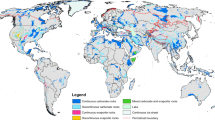Abstract
The presence of large amounts of gas and/or liquid hydrocarbon seepage in near surface sediments can produce distinct features including an irregular topography (on several scales, ranging from meters to kilometers); seismically transparent/chaotic sediments; oil staining; gas plumes; sediments containing elevated concentrations of extractable organic matter, organic carbon, and calcium carbonate; associated brine seepage and anoxic conditions; extensive bacterial mats; hydrate formation and decomposition; and dense chemoautotrophic communities. Although no single characteristic is always uniquely associated with seepage, the co-occurrence of several of these features is strongly suggestive of an area being exposed to non-indigenous upward migrating hydrocarbons.
Similar content being viewed by others
References
Anderson RK, Scalan RS, Parker PL, Behrens EW (1983) Seep oil and gas in Gulf of Mexico slope sediments. Science 222:619–622
Bauer JE, Montagna PA, Spies RB, Pieto MC, Hardin D (1988) Microbial biogeochemistry and heterotrophy in sediments of a marine hydrocarbon seep. Limnology and Oceanography 33:1493–1513
Behrens EQ (1988) Geology of a continental slope oil seep, northern Gulf of Mexico. Bulletin American Association Petroleum Geologists 72:105–114
Brooks JM, Kennicutt MC II, Fay RR, McDonald TJ, Sassen R (1984) Thermogenic gas hydrates in the Gulf of Mexico. Science 223:696–698
Brooks JM, Cox HB, Bryan WR, Kennicutt MC II, Mann RG, Mcdonald TJ (1986) Association of gas hydrates and oil seepage in the Gulf of Mexico. Organic Geochemistry 10:221–234
Brooks JM, Kennicutt MC II, Fisher CR, Macko SA, Cole K, Childress JJ, Bidigare RR, Vetter RD (1987) Deep sea hydrocarbon seep communities: evidence for energy and nutritional carbon sources. Science 238:1138–1142
Brooks JM, Kennicutt MC II, MacDonald IR, Wilkinson DL, Guinasso NL Jr, Bidigare RR (1989) Gulf of Mexico Hydrocarbon seep communities. Proceedings 21st Offshore Technology Conference, 5954:633–667
Hovland, M (1982) Pockmarks and the recent geology of the central section of the Norwegian Trench. Marine Geology 47:283–301
Hovland M, Judd AC, King LH (1984) Characteristic features of pockmarks on the North Sea floor and Scotian shelf. Sedimentology 31:471–480
Hovland M, Sommerville JH (1985) Characteristics of two natural gas seepages in the North Sea. Marine and Petroleum Geology 2:319–326
Hovland M, Thomsen E (1989) Hydrocarbon-based communities in the North Sea? Sarsia 74:29–42
Kennicutt MC II, Brooks JM, Bidigare RR, Fay RR, Wade TL, McDonald TJ (1985) Vent-type taxa in a hydrocarbon seep region on me Louisiana slope. Nature 317:351–353
Kennicutt MC II, Brooks JM, Bidigare RR, Denoux GJ (1988a) Gulf of Mexico hydrocarbon seep communities. I. Regional distribution of hydrocarbon seepage and associated fauna. Deep Sea Research 35:1639–1651
Kennicutt MC II, Brooks JM, Denoux GJ (1988b) Leakage of deep reservoired petroleum to the near surface on the Gulf of Mexico continental slope. Marine Chemistry 24:39–59
Kennicutt MC II, Brooks JM, Burke RA Jr (1989) Hydrocarbon seepage, gas hydrates, and authigenic carbonate in the northwestern Gulf of Mexico. Proceedings 21st Offshore Technology Conference, 5952:649–654
Link WH (1952) Significance of oil and gas seeps in world exploration. Bulletin American Association of Petroleum Geologists 365:1506–1514
MacDonald IR, Boland GS, Baker JS, Brooks JM, Kennicutt MC II, Bidigare RR (1989) Gulf of Mexico hydrocarbon seep communities. II. Spatial distribution of seep organisms and hydrocarbons at Bush Hill. Marine Biology 101:235–247
MacDonald IR, Reilly JF II, Guinasso NL Jr, Brooks JM, Carney RS, Bryan WA, Bright TJ (1990) Chemosynthetic mussels at a brine-filled pockmark in the northern Gulf of Mexico. Science 248:1096–1099
Montagna PA, Bauer JE, Pieto MC, Hardin D, Spies RB (1986) Benthic metabolism in a natural coastal petroleum seep. Marine Ecology, Progress 34:31–40
Montagna PA, Bauer JE, Toal J, Hardin, Spies RB (1987) Temporal variability and the relationship between benthic microfaunal and microbial populations of a natural coastal petroleum seep. Journal Marine Research 45:761–789
National Academy of Sciences (1985) Oil in the seas. Inputs, Fates, and Effects. Washington, DC, 601 pp
Prior DB, Doyle EH, Kaluza MJ (1989) Evidence of sediment eruption on deep sea floor, Gulf of Mexico. Science 243:517–519
Author information
Authors and Affiliations
Rights and permissions
About this article
Cite this article
Kennicutt, M.C., Brooks, J.M. Recognition of areas effected by petroleum seepage: Northern Gulf of Mexico continental slope. Geo-Marine Letters 10, 221–224 (1990). https://doi.org/10.1007/BF02431068
Received:
Revised:
Issue Date:
DOI: https://doi.org/10.1007/BF02431068




